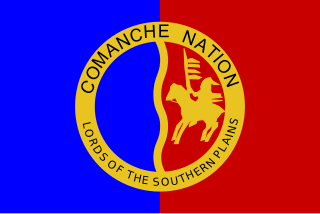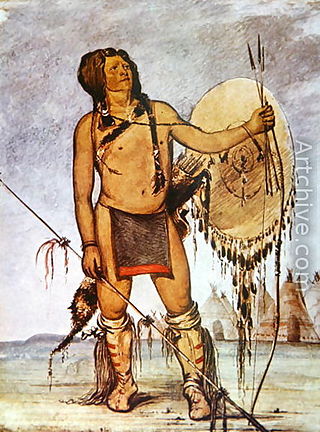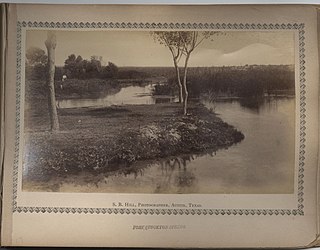Related Research Articles

Christopher Houston Carson was an American frontiersman. He was a fur trapper, wilderness guide, Indian agent and U.S. Army officer. He became a frontier legend in his own lifetime by biographies and news articles; exaggerated versions of his exploits were the subject of dime novels. His understated nature belied confirmed reports of his fearlessness, combat skills, tenacity, as well as profound effect on the westward expansion of the United States. Although he was famous for much of his life, historians in later years have written that Kit Carson did not like, want, or even fully understand the fame that he experienced during his life.

The Comanche or Nʉmʉnʉʉ are a Native American tribe from the Southern Plains of the present-day United States. Comanche people today belong to the federally recognized Comanche Nation, headquartered in Lawton, Oklahoma.

Hutchinson County is a county in the U.S. state of Texas. As of the 2020 census, its population was 20,617. Its county seat is Stinnett. The county was created in 1876, but not organized until 1901. It is named for Andrew Hutchinson, an early Texas attorney.

Quanah Parker was a war leader of the Kwahadi ("Antelope") band of the Comanche Nation. He was likely born into the Nokoni ("Wanderers") band of Tabby-nocca and grew up among the Kwahadis, the son of Kwahadi Comanche chief Peta Nocona and Cynthia Ann Parker, an Anglo-American who had been abducted as an eight-year-old child and assimilated into the Nokoni tribe. Following the apprehension of several Kiowa chiefs in 1871, Quanah Parker emerged as a dominant figure in the Red River War, clashing repeatedly with Colonel Ranald S. Mackenzie. With European-Americans hunting American bison, the Comanches' primary sustenance, into near extinction, Quanah Parker eventually surrendered and peaceably led the Kwahadi to the reservation at Fort Sill, Oklahoma.

The Llano Estacado, sometimes translated into English as the Staked Plains, is a region in the Southwestern United States that encompasses parts of eastern New Mexico and northwestern Texas. One of the largest mesas or tablelands on the North American continent, the elevation rises from 3,000 feet (900 m) in the southeast to over 5,000 feet (1,500 m) in the northwest, sloping almost uniformly at about 10 feet per mile (2 m/km).

The Comanche Wars were a series of armed conflicts fought between Comanche peoples and Spanish, Mexican, and American militaries and civilians in the United States and Mexico from as early as 1706 until at least the mid-1870s. The Comanche were the Native American inhabitants of a large area known as Comancheria, which stretched across much of the southern Great Plains from Colorado and Kansas in the north through Oklahoma, Texas, and eastern New Mexico and into the Mexican state of Chihuahua in the south. For more than 150 years, the Comanche were the dominant native tribe in the region, known as “the Lords of the Southern Plains”, though they also shared parts of Comancheria with the Wichita, Kiowa, and Kiowa Apache and, after 1840, the southern Cheyenne and Arapaho.

Plains Indians or Indigenous peoples of the Great Plains and Canadian Prairies are the Native American tribes and First Nation band governments who have historically lived on the Interior Plains of North America. While hunting-farming cultures have lived on the Great Plains for centuries prior to European contact, the region is known for the horse cultures that flourished from the 17th century through the late 19th century. Their historic nomadism and armed resistance to domination by the government and military forces of Canada and the United States have made the Plains Indian culture groups an archetype in literature and art for Native Americans everywhere.

The First Battle of Adobe Walls was a battle between the United States Army and American Indians. The Kiowa, Comanche and Plains Apache tribes drove from the battlefield a United States Expeditionary Force that was reacting to attacks on white settlers moving into the Southwest. The battle on November 25, 1864, resulted in light casualties on both sides but was one of the largest engagements fought on the Great Plains.

The Red River War was a military campaign launched by the United States Army in 1874 to displace the Comanche, Kiowa, Southern Cheyenne, and Arapaho Native American tribes from the Southern Plains, and forcibly relocate the tribes to reservations in Indian Territory. The war had several army columns crisscross the Texas Panhandle in an effort to locate, harass, and capture nomadic Native American bands. Most of the engagements were small skirmishes with few casualties on either side. The war wound down over the last few months of 1874, as fewer and fewer Indian bands had the strength and supplies to remain in the field. Though the last significantly sized group did not surrender until mid-1875, the war marked the end of free-roaming Indian populations on the southern Great Plains.

Comanche history is the story of the Native American (Indian) tribe which lived on the Great Plains of the present-day United States. In the 17th century the Eastern Shoshone people who became known as the Comanche migrated southward from Wyoming. In the 18th and 19th centuries the Comanche became the dominant tribe on the southern Great Plains. The Comanche are often characterized as "Lords of the Plains." They presided over a large area called Comancheria which they shared with allied tribes, the Kiowa, Kiowa-Apache, Wichita, and after 1840 the southern Cheyenne and Arapaho. Comanche power and their substantial wealth depended on horses, trading, and raiding. Adroit diplomacy was also a factor in maintaining their dominance and fending off enemies for more than a century. They subsisted on the bison herds of the Plains which they hunted for food and skins.
The Comanche campaign is a general term for military operations by the United States government against the Comanche tribe in the newly settled west. Between 1867 and 1875, military units fought against the Comanche people in a series of expeditions and campaigns until the Comanche surrendered and relocated to a reservation.
The Comancheros were a group of 18th- and 19th-century traders based in northern and central New Mexico. They made their living by trading with the nomadic Great Plains Indian tribes in northeastern New Mexico, West Texas, and other parts of the southern plains of North America. The name "Comancheros" comes from the Comanche tribe, in whose territory they traded. They traded manufactured goods, flour, tobacco, and bread for hides, livestock and slaves from the Comanche. As the Comancheros did not have regular access to weapons and gunpowder, there is disagreement about how much they traded these with the Comanche.

Ten Bears was the principal chief of the Yamparika or "Root Eater" division of the Comanche from ca. 1860-72. He was the leader of the Ketahto local group of the Yamparika, probably from the late 1840s.
The Texas–Indian wars were a series of conflicts between settlers in Texas and the Southern Plains Indians during the 19th-century. Conflict between the Plains Indians and the Spanish began before other European and Anglo-American settlers were encouraged—first by Spain and then by the newly Independent Mexican government—to colonize Texas in order to provide a protective-settlement buffer in Texas between the Plains Indians and the rest of Mexico. As a consequence, conflict between Anglo-American settlers and Plains Indians occurred during the Texas colonial period as part of Mexico. The conflicts continued after Texas secured its independence from Mexico in 1836 and did not end until 30 years after Texas became a state of the United States, when in 1875 the last free band of Plains Indians, the Comanches led by Quahadi warrior Quanah Parker, surrendered and moved to the Fort Sill reservation in Oklahoma.

The Battle of Blanco Canyon was the decisive battle of Col. Ranald S. Mackenzie's initial campaign against the Comanche in West Texas, and marked the first time the Comanches had been attacked in the heart of their homeland. It was also the first time a large military force explored the heart of Comancheria. On 12 August 1871 Mackenzie and Colonel Benjamin Grierson were asked by Indian Agent Lawrie Tatum to begin an expedition against the Kotsoteka and Quahadi Comanche bands, both of whom had refused to relocate onto a reservation after the Warren Wagon Train Raid. Col. Mackenzie assembled a powerful force consisting of eight companies of the Fourth United States Cavalry, two companies of the Eleventh Infantry, and a group of twenty Tonkawa scouts.

The Buffalo Soldier Tragedy of 1877, also known as the Staked Plains Horror, occurred when a combined force of Buffalo Soldier troops of the United States Army 10th Cavalry and local buffalo hunters wandered for five days in the Llano Estacado region of northwest Texas and eastern New Mexico during July of a drought year, where four soldiers and one buffalo hunter died.

A Cibolero was a Spanish colonial buffalo hunter from New Mexico. The Spanish word for buffalo as used in New Mexico is cibolo; hence, the name Cibolero for buffalo hunter.

Mow-way or Moway also referred to by European settlers as Shaking Hand or Hand Shaker, was the principal leader and war chief of the Kotsoteka band of the Comanche during the 1860s and 1870s, following the deaths of Kuhtsu-tiesuat in 1864 and Tasacowadi in 1872.

Maria Teresa "Teresita" Sandoval Suazo (1811–1894) was among the first women of European heritage to live in the Arkansas Valley of present-day Colorado. She is one of the founders of El Pueblo in the current city of Pueblo, Colorado. She managed a ranch, the Doyle Settlement, in her later years.

Comanche Springs was an aquifer of six artesian springs geographically located between the Edwards Plateau and the Trans-Pecos regions of West Texas. The military fortification Camp Stockton was built around the springs, eventually growing become the city of Fort Stockton.
References
- 1 2 3 4 5 6 7 Anderson, H. Allen. "Tafoya, Jose Piedad". The Handbook of Texas Online. Texas State Historical Association (TSHA). Retrieved 4 August 2017.
- 1 2 Anderson, H. Allen. "Comancheros". The Handbook of Texas Online. Texas State Historical Association (TSHA). Retrieved 4 August 2017.
- 1 2 3 4 "El Principe De Los Comancheros, Jose Piedad Tafoya". More Thoughts from New Mexico. Retrieved 4 August 2017.
- 1 2 3 4 5 6 7 8 9 Ellis, Mark R. "Tafoya, Jose Piedad". Encyclopedia of the Great Plains. University of Nebraska - Lincoln. Retrieved 4 August 2017.
- ↑ Dooley, Claude; Dooley, Betty (1978). Why Stop? A Guide to Texas Historical Roadside Markers (2nd ed.). Houston, Texas: Gulf Publishing Company. p. 408. ISBN 0-88415-922-1.
- 1 2 Haley, James L (1976). The Buffalo War - The History of the Red River Indian Uprising of 1874. Norman, Oklahoma: University of Oklahoma Press. pp. 175–176. ISBN 0-8061-1957-8.
- 1 2 3 Bowser, David (3 August 2007). "NM Ranch Includes Comancheros, Ownership Disputes In History". Livestock Weekly. Retrieved 4 August 2017.
- ↑ Fehrenbach, T. R. (1974). Comanches - The History of a People (1st Anchor Books ed.). Anchor Books. p. 541. ISBN 1-4000-3049-8.
- 1 2 Dan L. Thrapp (1 June 1991). Encyclopedia of Frontier Biography: P-Z. University of Nebraska Press. p. 1397. ISBN 0-8032-9420-4 . Retrieved 6 August 2017.
- ↑ Leckie, William H. (1967). The Buffalo Soldiers - A Narrative of the Negro Cavalry in the West. Norman, Oklahoma: University of Oklahoma Press. pp. 157-160. ISBN 0-8061-1244-1.
- ↑ Debra J. Sheffer Ph.D. (24 March 2015). The Buffalo Soldiers: Their Epic Story and Major Campaigns. ABC-CLIO. p. 104. ISBN 978-1-4408-2983-3.
- ↑ Sandoz, Mari (1954). The Buffalo Hunters. Lincoln, Nebraska: University of Nebraska Press. pp. 291-312. ISBN 0-8032-5883-6.
- ↑ Porter, Kenneth Wiggins (January 1952). "The Seminole-Negro Scouts". The Southwestern Historical Quarterly. LV (3).